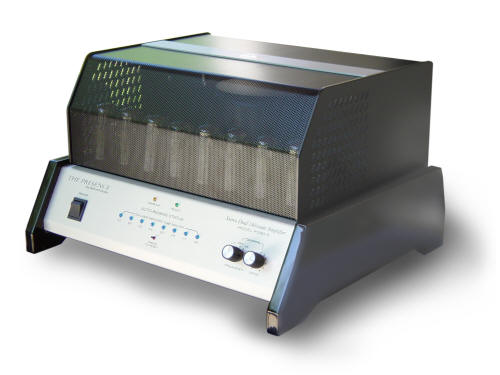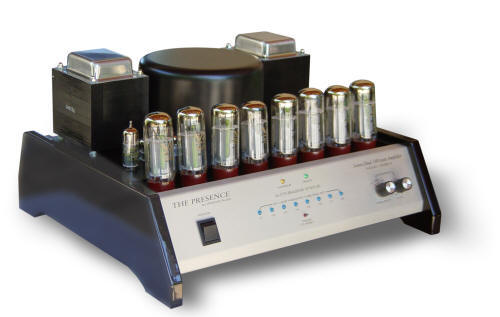You are reading the older HTML site
Positive Feedback
ISSUE
25
may/june
wolcott audio
P280-S amplifier
as reviewed by Karl Lozier

KARL LOZIER'S SYSTEM
LOUDSPEAKERS
ELECTRONICS
SOURCES
CABLES
ACCESSORIES
|
The Wolcott name seems to have dropped off the audio radar for the past year or two. This has happened despite the fact that Henry Wolcott has specialized in tube amplifier design for many years. In 1960, he designed the PL-100 power amp for JBL. Wolcott still uses that amplifier's circuit topology, with numerous upgrades, in his current products. It was awarded a U.S. patent, one of Wolcott's total of fourteen. The PL-100 evolved into his Optimation Company's model PA 250 instrumentation amplifier, a half dozen of which wound up being used at the U.S Bureau of Standards.
The lack of familiarity with the Wolcott name is at least partially due to the fact that the company occupies a niche position among the ever-expanding choices available in today's audio world. Wolcott amplifiers were never value-oriented, but in an attempt to keep prices as low as possible, Wolcott never bought expensive advertisements in the top print magazines. As a result, there were few, if any, reviews of Wolcott products in those magazines, and the lack of advertising meant that relatively few dealers carried the amplifiers. Some years ago, two respected audio reviewers, Dick Olsher and Dan Sweeny, gave praise to Wolcott products. In an Absolute Sound review of an extremely expensive solid-state power amp, Sweeney said that the amp was the first solid-state unit to offer bass response that equaled or surpassed that of the Wolcott. For a long time, Dick Olsher let it be known that he considered the largest Sound Lab electrostatic loudspeakers and the Wolcott amplifiers to be the most musical amp/speaker combination he had found.
When the word got around that Wolcott amplifiers did an outstandingly good job driving Sound Lab speakers, some audiophiles began to think that they were developed to drive those speakers. This did not make sense to anyone who really thought about it, but it gave pause to many potential buyers who never bothered to figure out that Wolcott amplifiers worked well with other hard-to-drive speakers, and would be loafing when used to drive most other speakers.
Since then, Wolcott has developed a few tweaks to his original design, in an attempt to improve it both measurably and audibly. He created a more powerful version of his mono amplifier, and now, this new stereo model (140-wpc). The P280-S was first shown over two years ago at CES. I was promised the first production unit for review, but it took a long time before Wolcott could put the amp into production. The P280-S features the Valve Art Company's newest EL-34B output tubes, with a larger bulb and more output than most EL-34s. It never seemed to strain, struggle, or change character during my listening sessions, at any output level. For those interested, Wolcott has a simple bridging adapter that turns this stereo amplifier into a mono amp delivering two hundred and eighty watts into an eight-ohm loudspeaker.
Wolcott describes the P280-S as a consumerized version of a rugged vacuum tube instrumentation amplifier, designed to set new standards for tube reliability, coupled with excellent but not outrageous build quality. Nothing has been done to make the amplifier look more impressive. At a glance, this new stereo amp looks the same as his older, monaural models. I find its appearance very pleasing, but admit that it may pale a bit in comparison with some of the recent, ridiculously expensive designs on which the manufacturers have spent as much on esthetics as they have on sound quality. With the protective cage off, the P280-S looks very nice, but as with most tube amplifiers, I recommend leaving the cage on. Those output tubes (and the chassis) can get very hot!
An unusual and potentially useful feature is an on/off switch on the rear panel for each of the inputs. This enables the user to change cables or input devices without having to turn the amplifier off. The bottom of the chassis is just high enough that it can be used on a reasonably thick carpet without needing to raise it higher. This unexpectedly powerful amplifier needs plenty of space around it to dissipate heat. For this reason, it would be a mistake to place a component immediately above it. Doing so would probably also cause noise or interference problems. I had a bit of a noise problem, one that Wolcott cleared up with a small change in the input wiring. All future units will incorporate this change.

Two rotary controls on the front panel adjust the effect of Wolcott's patented feedforward circuitry. This may be a major part of what makes Wolcott amplifiers outstanding. The amps have zero output impedance and an infinite, adjustable damping factor! The audible and measurable bass response can be tailored to the loudspeaker's requirements or the listener's taste. Many of you will know what that means, though you might not have known it could be done. For music lovers, it means that you can dial in the kind of bass you want, from the full and loose low end of a single-ended tube amp to the tightly controlled bass of a good solid state amp. The other front panel control is for optimizing the transient response of electrostatic loudspeakers.
Installing the P280-S was simple and straightforward. I let the amplifier play for a few hours, then started listening casually. The manufacturer had informed me that long burn-in and warm-up times were not necessary, and that turned out to be true. The sound did not change significantly over at least 200 hours of listening. I reached two complementary conclusions about the P280-S. Listeners used to good, neutral sounding solid-state power amplifiers will hear a rich, forward, strong midrange. The midrange is where the music lives. Do not listen to anyone who tries to tell you otherwise. Extensive listening to the P280-S resulted in nothing but musical enjoyment. I searched for negative aspects of its performance, but could find nothing that marred my enjoyment.
Does this mean that the P280-S is as good as an amplifier gets? Possibly. It is certainly up there with other amplifiers of similar power, at or near its price. Lovers of traditional tube amplifiers may have a little trouble with the P280-S at first, because it is more neutral. There is a great deal of truth to the statement that the best amplifiers, solid state and tube, are gradually starting to share certain sound qualities, or at least that the differences have been significantly minimized. The P280-S bridges the difference from both directions. It can provide the bass response desired by either solid-state or tube lovers (though not, of course, at the same time).
The P280-S' pleasing fullness remains at every setting, as does its midrange presence. This amplifier does not alter the natural quality of male or female voices. I never heard any bloat or boominess with male voices, or any edginess, harshness, or sibilant emphasis with female vocalists. With recordings by groups such as Spyro Gyra and Pieces of a Dream, or soloists such as Cheryl Bentyne and John Pizzarelli, the P280-S gave me the sensation of moving closer to the performers. Listening to a wide selection of classical music gave me similar reactions. I could almost feel the acoustics of the recording venues. In some Romantic pieces, the P280-S made solo horn passages almost come alive. Along with other top tube amps, the P280-S has the ability to create a sparkling, alive quality in the upper midrange/lower treble, yet along with that life-like quality, I heard no hint of higher-frequency emphasis. I also heard no trace of distortion or harshness. This may not make sense, but that's the way the amp sounded—very, very good.
Is this an amplifier for audiophiles or for music lovers? I believe it is an amplifier for both. I also believe that it is an amplifier for lovers of tube sound and lovers of solid-state sound. The tube lover can have the solid bass control usually missing from tube amplifiers. The solid-state lover can have the richness and sparkle reserved for tube amplifiers. Owners of electrostatic loudspeakers like Sound Labs or Quads—or any other hard-to-drive speakers—are ideal candidates for the P280-S. Word of mouth has gone a long way toward promoting the Wolcott name, and after many weeks of living with this new amplifier, I can see why. I recommend it highly, and I also feel comfortable recommending Wolcott's more powerful monoblock amplifiers if more power output is needed. Karl Lozier
Specifications
-
Power Output: 140 + 140 watts into 2-6 ohms
-
Frequency Response @1 watt: + o db - 3 db, 3Hz to 50 kHz
-
Dimensions: 17.5 x 15.5 x 20.5 (WxDxH inches)
-
Weight: Approximately 65 pounds
P280-S amplifier
Retail: $6500
Wolcott Audio
web address: www.wolcottaudio.com
Manufacturer's Comments
At Karl's suggestion, we would like to take this opportunity to add comments of a technical nature to his review that may be of interest to your readers. Interestingly, there is a unique similarity between the title of your magazine and a form of positive feedback used in our amplifier circuitry which we refer to "Differential feed forward technology" or simply DFF.
The excellent sound of our amplifier as reported in Mr. Lozier's review is a result of the culmination of many years of effort in the development of our DFF technology, which has enabled us to realize, in a tube power amplifier, what appear to be previously unattainable levels of low distortion, high damping factor and wide power bandwidth.
Full power bandwidth extends from 15Hz to over 20kHz. THD at full power output is typically 0.01% throughout the mid-band rising to less than 0.03% at 20Hz and 0.1% at 20kHz, and diminishing at lower levels. Damping factor is over 500, making the amplifier immune to speaker loading effects.
The design features that make this possible are not limited to our DFF technology but also include a proprietary output transformer design in which no negative feedback is taken from the output secondary and a digital auto-bias circuit which has the added advantage of enhancing output transformer response at low frequencies.
Henry O. Wolcott
Wolcott Audio
